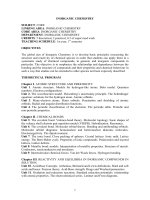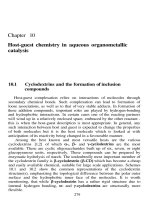Zvi goffer archaeological chemistry
Bạn đang xem bản rút gọn của tài liệu. Xem và tải ngay bản đầy đủ của tài liệu tại đây (4.38 MB, 654 trang )
ARCHAEOLOGICAL
CHEMISTRY
Second Edition
Zvi Goffer, Ph.D.
Retired Senior Scientist
Soreq Nuclear Research Center
Israel
WILEY-INTERSCIENCE
A JOHN WILEY & SONS, INC., PUBLICATION
www.pdfgrip.com
www.pdfgrip.com
ARCHAEOLOGICAL CHEMISTRY
Second Edition
www.pdfgrip.com
www.pdfgrip.com
ARCHAEOLOGICAL
CHEMISTRY
Second Edition
Zvi Goffer, Ph.D.
Retired Senior Scientist
Soreq Nuclear Research Center
Israel
WILEY-INTERSCIENCE
A JOHN WILEY & SONS, INC., PUBLICATION
www.pdfgrip.com
Copyright © 2007 by John Wiley & Sons, Inc. All rights reserved.
Published by John Wiley & Sons, Inc., Hoboken, New Jersey
Published simultaneously in Canada
No part of this publication may be reproduced, stored in a retrieval system, or transmitted in
any form or by any means, electronic, mechanical, photocopying, recording, scanning, or
otherwise, except as permitted under Section 107 or 108 of the 1976 United States Copyright
Act, without either the prior written permission of the Publisher, or authorization through
payment of the appropriate per-copy fee to the Copyright Clearance Center, Inc., 222
Rosewood Drive, Danvers, MA 01923, 978-750-8400, fax 978-750-4470, or on the web at
www.copyright.com. Requests to the Publisher for permission should be addressed to the
Permissions Department, John Wiley & Sons, Inc., 111 River Street, Hoboken, NJ 07030,
201-748-6011, fax 201-748-6008, or online at />Limit of Liability/Disclaimer of Warranty: While the publisher and author have used their
best efforts in preparing this book, they make no representations or warranties with respect
to the accuracy or completeness of the contents of this book and specifically disclaim any
implied warranties of merchantability or fitness for a particular purpose. No warranty may
be created or extended by sales representatives or written sales materials. The advice and
strategies contained herein may not be suitable for your situation. You should consult with a
professional where appropriate. Neither the publisher nor author shall be liable for any loss
of profit or any other commercial damages, including but not limited to special, incidental,
consequential, or other damages.
For general information on our other products and services or for technical support, please
contact our Customer Care Department within the United States at 877-762-2974, outside the
United States at 317-572-3993 or fax 317-572-4002.
Wiley also publishes its books in a variety of electronic formats. Some content that appears in
print may not be available in electronic formats. For more information about Wiley products,
visit our web site at www.wiley.com.
Wiley Bicentennial Logo: Richard J. Pacifico
Book cover illustration and line drawings by the author.
Library of Congress Cataloging-in-Publication Data:
Goffer, Zvi.
Archaeological chemistry / Zvi Goffer. – 2nd ed.
p. cm.
Includes bibliographical references and index.
ISBN 978-0-471-25288-7 (cloth)
1. Archaeological chemistry. I. Title.
CC79.C5G63 2007
930.1028 – dc22
2005028992
Printed in the United States of America
10 9 8 7 6 5 4 3 2 1
www.pdfgrip.com
To the memory of my parents
Rivka and Moshe
www.pdfgrip.com
www.pdfgrip.com
CONTENTS
PREFACE
ACKNOWLEDGMENTS
1.
MINERALS: Rock and Stone: Pigments, Abrasives,
and Gemstones
1.1
The Chemical Elements
1.2
Minerals and Mineraloids
1.3
Rock and Stone
1.4
Study of Archaeological Stone
1.5
Chemical Analysis of Archaeological Materials
Isotopes in Archaeology
1.6
Provenance of Archaeological Materials
1.7
Chronology of Archaeological Materials
Potassium–Argon Dating
Argon–Argon Dating
Archaeologically Related Rock and Stone
1.8
Pigments
White Pigments
Black Pigments
Red Pigments
Yellow Pigments
Green Pigments
Blue Pigments
1.9
Abrasives
1.10 Gemstones
Cutting and Polishing Gemstones
Some Archaeological Gemstones
xvii
xxi
1
1
6
24
26
29
39
42
43
50
55
55
62
67
68
72
74
74
75
75
76
89
89
vii
www.pdfgrip.com
viii
CONTENTS
2. LITHICS: Flint and Obsidian
2.1 Quartz and Flint
2.2 Obsidian
Dating Obsidian
2.3 Use Wear Analysis
93
93
99
102
109
3. SAND: Glass, Glaze, and Enamel
3.1 Glass, Glaze, and Enamel
3.2 Glass
Soda Glass
Sodalime Glass
Potash Glass
Lead Glass
Colored Glass
Opaque Glass
3.3 Glassmaking
3.4 Ancient Glass Studies
Some Special Types of Ancient Glass
The Provenance of Glass
3.5 The Decay of Glass
111
112
115
115
118
119
119
120
122
124
128
130
132
134
4. SECONDARY ROCKS: Building Stone, Brick, Cement,
and Mortar
4.1 Building Stone
Gypsum and Alabaster
Limestone and Marble
4.2 Cement
Mud
Bitumen
Lime and Gypsum Cements
4.3 Study of Ancient Cements
139
139
140
141
142
144
146
147
152
5. ORES: Metals and Alloys
5.1 Native Metals
5.2 Metalliferous Ores
5.3 Mining
5.4 Ore Dressing
5.5 Smelting
Smelting Fuel and Metal Reduction
5.6 Metal Refining
5.7 Alloys
153
158
159
159
160
160
163
164
165
www.pdfgrip.com
ix
CONTENTS
5.8
5.9
5.10
The Metals and Alloys of Antiquity
Copper
Iron
Gold
Silver
Lead
Tin
Zinc
Mercury
Platinum
Deterioration of Metals and Alloys – Corrosion
Corrosion of Ancient Metals and Alloys
Studies on Archaeological Metals and Alloys
Ancient Metallurgy
Arsenical Copper
Damascus Steel
Granulation and Filigree
Coins
167
167
172
175
179
180
183
185
186
188
188
193
198
200
201
203
204
206
6.
SEDIMENTS AND SOILS
6.1
Sediments, Oxygen Isotopes, and Ancient Temperatures
6.2
Soil
Composition and Properties of Soils
Archaeological Soils
209
214
218
221
226
7.
CLAY: Pottery and Other Ceramic Materials
7.1
Primary Clay
7.2
Secondary Clay
7.3
Clay and Ceramic Materials
7.4
Ceramic Materials
Preceramics
Components of Ceramic Materials
7.5
Making Ceramics
Pottery Kilns
The Color of Fired Pottery
Glazing
7.6
Common Ceramic Materials
Terracotta
Earthenware
Stoneware
Porcelain
231
233
234
235
237
239
240
240
243
245
245
246
246
248
249
249
www.pdfgrip.com
x
CONTENTS
7.7
Study of Ancient Pottery
Attic Vase Painting
Coral Red Attic Pottery
Manganese Black Decoration
Islamic Stone-Paste
Egyptian Faience
Firing Conditions of Ancient Pottery
The Provenance of Pottery
Dating Pottery
250
251
254
254
254
255
257
257
260
8.
THE BIOSPHERE: Organic and Biological Substances
8.1
Living Organisms and Cells
8.2
Biological Matter: Organic and Bioinorganic Substances
Organic Substances
Bioinorganic Substances
8.3
Ancient Biological Materials
8.4
Dating Organic Materials
Radiocarbon Dating
261
262
265
268
270
271
272
273
9.
CARBOHYDRATES: Wood, Gums, and Resins
9.1
Wood
The Nature of Wood
The Composition and Physical Properties of Wood
Dendrochronology and Dendroclimatology
Dead Wood
Burned Wood
Archaeological Wood
9.2
Gums
9.3
Resins
Lacquers
Incense
9.4
Carbohydrates, Isotopes, and Study of Ancient Diets
289
293
293
294
296
299
300
301
301
303
306
306
307
LIPIDS: Oils, Fats, and Waxes; Soap
10.1
Oils, Fats, and Waxes
Oils
Fats
Waxes
10.2
Ancient Oils, Fats, and Waxes
10.3
Soap
311
311
313
315
316
318
318
10.
www.pdfgrip.com
CONTENTS
11.
xi
PROTEINS: Skin, Leather, and Glue
11.1
Animal Skin
Skin and Hide
Fur
Parchment and Vellum
11.2
Leather
Tanning
Aftertanning Processes; Finishing
11.3
Glue
11.4
Dating Ancient Proteins – Amino Acid Racemization
Dating
321
328
330
331
332
332
333
337
337
12.
THE NUCLEIC ACIDS: Human Traits; Genetics and Evolution
12.1
DNA and RNA
DNA After Death
12.2
The Polymerase Chain Reaction (PCR)
12.3
Ancient DNA Studies
343
343
348
349
352
13.
FIBERS: Yarn, Textiles, and Cordage; Writing Materials
13.1
Fibers, Textile, and Cordage
Vegetable Fibers
Animal Fibers
Inorganic Fibers
13.2
Archaeological Fibers and Fibrous Materials
13.3
Writing Materials
Papyrus
Paper
Nonpaper Flat Materials
353
353
356
358
360
361
362
362
363
363
14.
DYES AND DYEING
14.1
Stains and Staining
14.2
The Dyeing Process
14.3
Mordants
14.4
The Nature of Dyes
14.5
Ancient Dyes
Blue Dyes
Green Dyes
365
365
367
367
367
371
372
373
338
www.pdfgrip.com
xii
CONTENTS
14.6
15.
16.
17.
Purple Dyes
Red Dyes
Yellow Dyes
Identification and Characterization of Ancient Dyes
and Mordants
373
374
376
378
BIOINORGANIC MATERIALS: Bone, Ivory, and Shell;
Phytoliths
15.1
Hard Animal Tissues
Bone
Teeth
Ivory
Horn
Antler
Shell
15.2
Archaeological Bone
Diagenesis of Buried Bone
Dating Bone
15.3
Bone, Stable Isotopes, and Ancient Diets
Nitrogen Stable Isotopes and Diet
Strontium Isotopes
379
380
380
382
382
383
384
384
385
385
386
390
390
391
SOME ANCIENT REMAINS: Mummies, Fossils, and
Coprolites
16.1
Mummies and Mummification
Embalming
16.2
Fossils and Fossilization
16.3
Animal Excretions
Coprolites
393
393
396
399
401
402
THE ENVIRONMENT AND DECAY OF
ARCHAEOLOGICAL MATERIALS
17.1
Air and the Atmosphere
Composition of the Atmosphere
17.2
Water and the Hydrosphere
17.3
Pollution
Air Pollutants
Water Pollutants
17.4
The Interaction of Materials with the Environment
Temperature Effects
Sunlight
405
406
408
411
418
420
420
423
423
426
www.pdfgrip.com
xiii
CONTENTS
17.5
18.
Oxygen and Ozone
Water
Air Pollutants
Soil Pollutants
Deterioration of Some Archaeological Materials
Pottery
Glass
Metals
Wood
Skin, Hide, and Leather
Fibrous Matter
AUTHENTICATION OF ANTIQUITIES
18.1
Technical and Scientific Methods of Authentication
Material Evidence
Scientific Examination
18.2
Some Authentication Studies
The Piltdown Man
Francis Drake’s Brass Plate
The Greek Bronze Horse from the Metropolitan
Museum
The Shroud of Turin
TEXTBOXES
1.
Matter and Materials; Elements and Substances
2.
The Structure of Matter: Atoms and Molecules
3.
The States of Matter
4.
The Properties of Matter
5.
Electromagnetic Radiation; Waves
6.
Atoms and Molecules; Chemical Nomenclature and
Formulas
7.
Mineral- and Rock-Forming Processes – Crystallization
and Precipitation
8.
The Composition of Materials: Major, Minor, and Trace
Components
9.
Analytical Chemistry
10.
Physical Methods of Analysis Frequently Used in
Archaeological Studies
11.
Nondestructive Testing and Microanalysis
12.
Isotopes
13.
Radioactivity
427
427
428
429
429
429
430
431
431
432
432
433
435
436
437
440
440
442
442
443
2
6
12
15
16
20
25
27
30
34
38
39
45
www.pdfgrip.com
xiv
CONTENTS
14.
15.
16.
17.
18.
19.
20.
21.
22.
23.
24.
25.
26.
27.
28.
29.
30.
31.
32.
33.
34.
35.
36.
37.
38.
39.
40.
41.
42.
43.
44.
45.
46.
47.
48.
49.
50.
51.
52.
Half-Life
Potassium–Argon and Argon–Argon Dating
Uranium Series Dating
Color and Colorants – Pigments and Dyes
Paint and Painting
Allotropes
Man Made Pigments: Frits and Lakes
The Structure of Solids: Amorphous and Crystalline
Materials
Light: Its Nature and Properties
Hardness
Thermoluminescence and Optically Stimulated
Luminescence Dating
The Hydration of Obsidian
Fission Track Dating
Supercooled Liquids; Glass and Vitreous Materials
Flux
Thermal Operations: Annealing, Tempering, and Sintering
The Isotopes of Lead
Cement
Composite Materials
Calcination and Roasting
Lime Cement; Quicklime, Slaked Lime
Gypsum Cement (Plaster of Paris)
Metals and Alloys
Metals Smelting and Refining
Shaping Materials: Cast and Wrought Objects
Lead Smelting
Zinc Smelting
Mercury Smelting
Corrosion
Bronze Disease
Metal Joining Techniques: Soldering and Welding
Weathering
Diagenesis
Stable Isotopes of Oxygen and Ancient Temperatures
Acids and Bases: The pH of Solutions
Refractory and Ceramic Materials
The Living Cell
Organic Substances
Radiocarbon Dating
48
51
57
63
65
69
73
77
81
87
96
103
106
113
115
126
133
142
143
147
149
150
155
161
165
181
185
187
190
195
204
211
212
215
222
238
262
266
273
www.pdfgrip.com
xv
CONTENTS
53.
54.
55.
56.
57.
58.
59.
60.
61.
62.
63.
64.
65.
66.
67.
68.
69.
70.
71.
72.
73.
74.
75.
Carbohydrates
Wood: Hardwoods and Softwoods
Adhesives; Sizes and Binders
Stable Carbon Isotopes and Ancient Diets
The Lipids
Polymers
Amino Acids, Polypeptides, and Proteins
The Proteins
Collagen
Tannins
Optical Isomers, Chirality, and Racemization
The Nucleic Acids: DNA and RNA
The Polymerase Chain Reaction (PCR)
Fibers and Fibrous Materials
The Fluoridation of Bone
Imaging
Taphonomy
Atmospheric Pressure
Humidity
Water
Hard Water: Scale and Incrustations
Acid Rain
The Thermal Properties of Solids
289
295
302
308
312
314
322
324
327
334
338
344
349
354
388
396
400
407
411
412
415
421
423
Appendix I: The Chemical Elements
445
Appendix II: Chronometric Dating Methods: Selection Criteria
449
Appendix III: Symbols, Constants, Units, and Equivalencies
453
Glossary
455
Bibliography
529
Index
603
www.pdfgrip.com
www.pdfgrip.com
PREFACE
Modern archaeological research involves collaboration of archaeologists and
natural scientists. A virtual alphabet of scientific disciplines, ranging from
aerology to zymurgy, today contribute to the elucidation of archaeological
issues; some of these disciplines, however, among them chemistry and materials science, are more closely associated with archaeology than others.
Although the foundations of modern chemistry as a science were laid only
about two hundred years ago, and those of materials science even more
recently, humans have always come into contact with chemicals and materials, experienced chemical activity, and developed chemical processes.
All materials, whether of natural origin or made by humans – the air we
breathe, the food we eat, the cement we use to construct buildings and roads,
the metals we shape into working tools, decorative objects or weapons, and
the fibers we spin into yarn and then weave or knit into cloth – all are either
chemical substances or mixtures of chemical substances. Cooking involves
chemical processes at high temperatures that alter the physical state
and chemical properties of the food. The production of wine and beer
involves chemical processes, as do dyeing yarn and cloth or extracting
metals from their ores; and pottery- and glassmaking involve particularly
intricate and complex chemical processes.
Thus chemicals and the processing of chemical substances have always
been part of the human experience. It seems obvious, then, that the practice
of archaeology, which is the study of the human past through the analysis
of its material remains, requires a thorough understanding of the chemical
nature and properties of these remains.
The application of chemical methods to archaeology, which can be conveniently referred to under the collective term “archaeological chemistry”
began just about one hundred years ago, has greatly broadened since the
mid twentieth century and is shedding ever increasing light on the nature
of materials and the processes used to make and change them in the past.
Today, archaeological chemistry provides not only ways to identify and
xvii
www.pdfgrip.com
xviii
PREFACE
characterize ancient materials, it also makes it possible to establish how and
when materials were worked, altered or manufactured, ascertain their
provenance, and trace the routes along which they were transported and
traded.
The first materials used by early humans for building and for the making
of artifacts and clothing were naturally occurring minerals and stones, as
well as wood, bone, and fur, derived from plants or animals, all of which
could be gathered, more or less easily, from the surface of the earth or the
surrounding environment. With the passing of time and the gaining of experience, humans discovered processes for extracting other materials from
those they gathered, and learned how to make from them new materials
more appropriate to their needs. Thus began a process of developing technologies for extracting metals from mineral ores, deriving fibers and dyes
from plant or animal tissues, and making glass from sand and ceramics from
clay, all of which still continue today.
It seems appropriate, therefore, to begin a survey of archaeological materials with a discussion of inorganic materials – from minerals and rocks, the
most abundant materials on the planet, to those extracted, derived, or made
from them, such as metals and alloys, glass and ceramics (Chapters 1–7).
Organic and biological materials produced by, or derived from plants or
animals are discussed next (Chapters 8–15). Finally, the atmosphere and the
hydrosphere, which make up most of the environment that affects all materials and determines the way they decay, are surveyed (Chapter 17).
The subject matter included in the chapters was compiled during many
years of investigating and teaching about archaeological materials, and I
believe the book provides an overview of the present standing of archaeological chemistry studies. This second edition of Archaeological Chemistry, like
its predecessor, has been written in such a way as to provide an introduction to the subject. I have tried to furnish extensive references for those who
wish to pursue particular aspects in greater depth; I did not, however,
attempt to present an exhaustive survey of the literature, since many of the
publications on the subjects discussed tend to be repetitive and often convey
little that is new.
The field covered by archaeological chemistry, has expanded greatly
since the first edition of Archaeological Chemistry was published over twentyfive years ago. There was at that time, relatively little information on the
chemistry of ancient materials or the application of chemical methods to
archaeology, whereas archaeological chemistry studies today attract the
attention of large numbers of scientists. Not only the range but also the complexity of archaeological subjects to which chemical methods are now
applied have expanded vastly since the appearance of the first edition. This
www.pdfgrip.com
PREFACE
xix
has been due mainly, to the development of new, sophisticated analytical
instrumentation and of techniques for the study – important in the archaeological context – of ever-smaller samples of a continuously growing range
of materials. These developments, together with increasing knowledge
about the processing of analytical results, have made possible a coherent
interpretation of the results of archaeological studies. The growth in interest, and in the amount of information available, is reflected in the scientific
literature and in the numerous meetings on archaeological studies organized
by prestigious scientific organizations such as the Royal Society in Britain,
the Centre National de la Recherche Scientifique in France, the Max Planck
Gesellschaft in Germany, the American Chemical Society, and others
throughout the world.
In this second edition I have updated much of the material contained in
the first one, and introduced, throughout the text, modifications to include
the latest research contributions in the field. As a consequence of advances
in knowledge and interpretation, however, the archaeological chemistry literature is ever burgeoning; this compelled me to be particularly selective of
the topics and the bibliographic material to be included in the book.
Aware of the need to maintain scientific accuracy while at the same time
keeping the book accessible to readers not familiar with the complexity of
scientific writing, I have divided the book into two intertwining and complementary sections: text and textboxes. In the text the uses and applications
of chemistry to archeology are discussed, avoiding the use of highly technical chemical language. In the textboxes are expanded discussions of chemical subjects only concisely presented in the text, and explanations of chemical
concepts and nomenclature. Reading them is optional and not much will
be lost on the topical consideration of the subjects by ignoring them altogether. All chemical subjects considered in the book should, therefore, be
easily understood by those not familiar with the terminology of chemical
literature.
Zvi Goffer
Rehovot, Israel
June 2007
www.pdfgrip.com
www.pdfgrip.com
ACKNOWLEDGMENTS
Few scientific books, nowadays, can be written by just one person. Even
though I am credited by the publisher with being the sole author of this book,
Archaeological Chemistry is no exception. It is with great pleasure and
appreciation, therefore, that I acknowledge my indebtedness to the people
who encouraged me and provided a helping hand during its writing.
Members of the Kimmel Center for Archaeological Science at the Weizmann
Institute of Science, Rehovot, Israel, helped with many suggestions and also
served as a sounding board for the initial writing; special thanks are due to
Francesco Berna, Elizabetta Boaretto, Eugenia Mintz, Ruth Shahak, Sariel
Shalev, and Stephen Weiner of the Center. My recognition and gratitude are
also due to John Elmsley of the University of Cambridge and Dafydd Griffiths of University College, London, England, Motti Findler of the Hadassah
Medical Center and Archie Kauffmann of the Weizmann Institute of Science,
Israel, Milton Taylor of Indiana University and Robert H. Tycott of the University of South Florida, USA, and to my friends Helen and Bruce Christie
of Australia and Lionel Holland of Israel, for their counsel and advice. Their
comments and critique led me to correct errors and clarify passages or illustrations that otherwise might have made parts of the book vague or obscure.
I am much obliged to Danny Kijel and Vicky Shklarman, who assisted me
with the artwork and to Evelyn Katrak who edited my language and made
it more comprehensible.
I also thank the following for permission to reproduce their photographs: the late I. Perlman (Fig. 14); the Israel Antiquities Authority (Figs.
19, 32, 35, 36, 38, 43, 54, 55, 57, 68 and 80); M. Prausnitz (Fig. 21); I. Friedman (Fig. 23); R. L. Fleisher (Figs. 24, 25); Eretz Israel Museum, Tel Aviv,
Israel (Figs. 27, 28, 56); R. H. Brill (Fig. 29); Y. Beit Arieh (Figs. 31, 37 and 79);
J. M. Curran (Fig. 44); F. de Korosy (Fig. 52); E. Boaretto and J. Heinemeir
(Fig. 63); E. Aspillaga and B. Ahrensberg (Fig. 81). Thanks are also due to
Z. Herzog for permission to photograph the archaeological finds on the
cover illustration.
xxi
www.pdfgrip.com
xxii
ACKNOWLEDGMENTS
The facilities provided by the Kimmel Center for Archaeological Science
at the Weizmann Institute of Science, Rehovot, Israel, and the Institute of
Archaeology, University College, London, England, served as heavenly
places in which to gather data and write; the libraries and librarians of both
these institutions provided unlimited help and inexhaustible sources of
information.
Chava, my wife, and Ailit, my daughter, acquiesced with love and
understanding to the long hours when my mind was in archaeological chemistry rather than with my family. They both stood, as always, by my side,
helping me create a better book, improving my language, and restraining
excesses in my writing.
I am, however, the only person answerable for any faults, errors, and
other shortcomings that may still remain in the book.
Z. G.
www.pdfgrip.com
MINERALS
ROCK AND STONE:
PIGMENTS, ABRASIVES,
AND GEMSTONES
1
The outer crust of earth has provided the solid foundation for the evolution
of human beings, who are the prime focus of interest and concern to archaeology. The main components of this crust are minerals and rocks, some consolidated and others occurring as sediments, nonconsolidated deposits, created
by weathering processes from the minerals and rocks. All these minerals,
rocks, and sediments, as well as everything else in the universe, are made
up from just over 100 chemical elements listed in Appendix I. Most of the elements in the crust of the earth occur in extremely low relative amounts, and
only a few, listed in Table 1, make up almost 99% of its total bulk (Bloom
1969).
1.1.
THE CHEMICAL ELEMENTS
There are two basic types of elements: metals and nonmetals. The metals, such
as copper, gold, and iron (see Chapter 5), make up more than three-quarters
of the total number of elements; nonmetals, such as, for example, chlorine,
sulfur and carbon, make up much of the rest. Other elements, however,
known as the metalloids or semimetals, have properties intermediary between
the metals and the nonmetals (see Appendix I). Only a few elements, such
as the metals gold and copper and the nonmetal sulfur, which are known as
the native elements, occur in nature uncombined. Most elements occur naturally combined with others, forming compounds. It is from these compounds,
which occur in the crust of the earth as minerals, rocks, or sediments, that
humans extract most of the elements that they require (Klein 2000).
Archaeological Chemistry, Second Edition By Zvi Goffer
Copyright © 2007 John Wiley & Sons, Inc.
1









